-
Java Tutorial
- what-is-java
- history-of-java
- features-of-java
- c++-vs-java
- hello-java-program
- program-internal
- how-to-set-path?
- jdk,-jre-and-jvm
- jvm:-java-virtual-machine
- java-variables
- java-data-types
- unicode-system
- operators
- keywords
Control Statements
- java-if-else
- java-switch
- java-for-loop
- java-while-loop
- java-do-while-loop
- java-break
- java-continue
- java-comments
- java-programs
Java Object Class
- java-oops-concepts
- naming-convention
- object-and-class
- method
- constructor
- static-keyword
- this-keyword
Java Inheritance
Java Polymorphism
- method-overloading
- method-overriding
- covariant-return-type
- super-keyword
- instance-initializer-block
- final-keyword
- runtime-polymorphism
- dynamic-binding
- instanceof-operator
Java Abstraction
Java Encapsulation
Java Array
Java OOPs Misc
- object-class
- object-cloning
- math-class
- wrapper-class
- java-recursion
- call-by-value
- strictfp-keyword
- javadoc-tool
- command-line-arg
- object-vs-class
- overloading-vs-overriding
Java String
- what-is-string
- immutable-string
- string-comparison
- string-concatenation
- substring
- methods-of-string-class
- stringbuffer-class
- stringbuilder-class
- string-vs-stringbuffer
- stringbuffer-vs-builder
- creating-immutable-class
- tostring-method
- stringtokenizer-class
- java-string-faqs
Java String Methods
- string-charat()
- string-compareto()
- string-concat()
- string-contains()
- string-endswith()
- string-equals()
- equalsignorecase()
- string-format()
- string-getbytes()
- string-getchars()
- string-indexof()
- string-intern()
- string-isempty()
- string-join()
- string-lastindexof()
- string-length()
- string-replace()
- string-replaceall()
- string-split()
- string-startswith()
- string-substring()
- string-tochararray()
- string-tolowercase()
- string-touppercase()
- string-trim()
- string-valueof()
Java Regex
Exception Handling
- java-exceptions
- java-try-catch-block
- java-multiple-catch-block
- java-nested-try
- java-finally-block
- java-throw-keyword
- java-exception-propagation
- java-throws-keyword
- java-throw-vs-throws
- final-vs-finally-vs-finalize
- exception-handling-with-method-overriding
- java-custom-exceptions
Java Inner Class
- what-is-inner-class
- member-inner-class
- anonymous-inner-class
- local-inner-class
- static-nested-class
- nested-interface
Java Multithreading
- what-is-multithreading
- life-cycle-of-a-thread
- creating-thread
- thread-scheduler
- sleeping-a-thread
- start-a-thread-twice
- calling-run()-method
- joining-a-thread
- naming-a-thread
- thread-priority
- daemon-thread
- thread-pool
- thread-group
- shutdownhook
- performing-multiple-task
- garbage-collection
- runtime-class
Java Synchronization
- synchronization-in-java
- synchronized-block
- static-synchronization
- deadlock-in-java
- inter-thread-comm
- interrupting-thread
- reentrant-monitor
Java I/O
- java-input/output
- fileoutputstream
- fileinputstream
- bufferedoutputstream
- bufferedinputstream
- sequenceinputstream
- bytearrayoutputstream
- bytearrayinputstream
- dataoutputstream
- datainputstream
- java-filteroutputstream
- java-filterinputstream
- java-objectstream
- java-objectstreamfield
- console
- filepermission
- writer
- reader
- filewriter
- filereader
- bufferedwriter
- bufferedreader
- chararrayreader
- chararraywriter
- printstream
- printwriter
- outputstreamwriter
- inputstreamreader
- pushbackinputstream
- pushbackreader
- stringwriter
- stringreader
- pipedwriter
- pipedreader
- filterwriter
- filterreader
- file
- filedescriptor
- randomaccessfile
- java.util.scanner
Java Serialization
Java Networking
- networking-concepts
- socket-programming
- url-class
- urlconnection-class
- httpurlconnection
- inetaddress-class
- datagramsocket-class
Java AWT & Events
- awt-basics
- event-handling
- awt-button
- awt-label
- awt-textfield
- awt-textarea
- awt-checkbox
- awt-checkboxgroup
- awt-choice
- awt-list
- awt-canvas
- awt-scrollbar
- awt-menuitem-menu
- awt-popupmenu
- awt-panel
- awt-dialog
- awt-toolkit
- java-actionlistener
- java-mouselistener
- mousemotionlistener
- java-itemlistener
- java-keylistener
- java-windowlistener
- java-adapter-classes
- close-awt-window
Java Swing
- swing-introduction
- java-jbutton
- java-jlabel
- java-jtextfield
- java-jtextarea
- java-jpasswordfield
- java-jcheckbox
- java-jradiobutton
- java-jcombobox
- java-jtable
- java-jlist
- java-joptionpane
- java-jscrollbar
- java-jmenuitem-jmenu
- java-jpopupmenu
- java-jcheckboxmenuitem
- java-jseparator
- java-jprogressbar
- java-jtree
- java-jcolorchooser
- java-jtabbedpane
- java-jslider
- java-jspinner
- java-jdialog
- java-jpanel
- java-jfilechooser
- java-jtogglebutton
- java-jtoolbar
- java-jviewport
- java-jframe
- java-jcomponent
- java-jlayeredpane
- java-jdesktoppane
- java-jeditorpane
- java-jscrollpane
- java-jsplitpane
- java-jtextpane
- java-jrootpane
- using-tooltip
- change-title-icon
- executable-jar-file
- digital-watch
- graphics-in-swing
- displaying-image
Java Swing Apps
- notepad
- calculator
- ip-finder
- word-counter
- url-source-generator
- folder-explorer
- puzzle-game
- pic-puzzle-game
- tic-tac-toe-game
- online-exam
LayoutManagers
- borderlayout
- gridlayout
- flowlayout
- boxlayout
- cardlayout
- gridbaglayout
- grouplayout
- springlayout
- scrollpanelayout
JavaFX Tutorial
- javafx-tutorial
- install-java
- install-eclipse
- javafx-with-eclipse
- javafx-architecture
- application-structure
- first-javafx-application
JavaFX 2D Shapes
- javafx-2d-shapes
- shape-properties
- javafx-line
- javafx-rectangle
- javafx-ellipse
- javafx-arc
- javafx-circle
- javafx-polygons
- cubic-curve
- quad-curve
- javafx-color
- gradient-color
JavaFX Text
JavaFX Effects
- javafx-effects
- javafx-coloradjust
- javafx-colorinput
- javafx-imageinput
- javafx-blend
- javafx-bloom
- javafx-glow
- javafx-boxblur
- javafx-gaussianblur
- javafx-motionblur
- javafx-reflection
- javafx-sepiatone
- javafx-shadow
- javafx-dropshadow
- javafx-innershadow
- javafx-lighting
- javafx-light.distant
- javafx-light.spot
- javafx-light.point
JavaFX Transformation
- javafx-transformation
- javafx-translation
- javafx-rotation
- javafx-scaling
- javafx-shearing
- multiple-transformations
JavaFX Animation
- javafx-animation
- javafx-rotate-transition
- javafx-scale-transition
- javafx-translate-transition
- javafx-fade-transition
- javafx-fill-transition
- javafx-stroke-transition
- javafx-sequential-transition
- javafx-parallel-transition
- javafx-pause-transition
- javafx-path-transition
JavaFX 3D Shapes
JavaFX Layouts
- javafx-layouts
- javafx-borderpane
- javafx-hbox
- javafx-vbox
- javafx-stackpane
- javafx-gridpane
- javafx-flowpane
JavaFX UI
- javafx-ui-controls
- javafx-label
- javafx-button
- javafx-radiobutton
- javafx-checkbox
- javafx-textfield
- javafx-passwordfield
- javafx-hyperlink
- javafx-slider
- javafx-progressbar
- progress-indicator
- javafx-scrollbar
- javafx-filechooser
- javafx-menu
- javafx-tooltip
JavaFX Charts
- javafx-charts
- javafx-pie-chart
- javafx-line-chart
- javafx-area-chart
- javafx-bar-chart
- javafx-bubble-chart
- javafx-scatter-chart
- stacked-area-chart
- stacked-bar-chart
JavaFX CSS
Media with JavaFX
JavaFX Event Handling
Java Applet
- applet-basics
- graphics-in-applet
- displaying-image-in-applet
- animation-in-applet
- eventhandling-in-applet
- japplet-class
- painting-in-applet
- digital-clock-in-applet
- analog-clock-in-applet
- parameter-in-applet
- applet-communication
Java Reflection
- reflection-api
- newinstance()-method
- javap-tool
- creating-javap-tool
- creating-appletviewer
- call-private-method
Java 8 Date Time
- java-date-time-api
- java-localdate
- java-localtime
- java-localdatetime
- java-monthday
- java-offsettime
- java-offsetdatetime
- java-clock
- java-zoneddatetime
- java-zoneid
- java-zoneoffset
- java-year
- java-yearmonth
- java-period
- java-duration
- java-instant
- java-dayofweek-enum
- java-month-enum
Java Date (Classical)
Java Date Format
Current Date Time
Java Conversion
- java-string-to-int
- java-int-to-string
- java-string-to-long
- java-long-to-string
- java-string-to-float
- java-float-to-string
- java-string-to-double
- java-double-to-string
- java-string-to-date
- java-date-to-string
- java-string-to-char
- java-char-to-string
- java-string-to-object
- java-object-to-string
- java-int-to-long
- java-long-to-int
- java-int-to-double
- java-double-to-int
- java-char-to-int
- java-int-to-char
- java-string-to-boolean
- java-boolean-to-string
- date-to-timestamp
- timestamp-to-date
- binary-to-decimal
- decimal-to-binary
- hex-to-decimal
- decimal-to-hex
- octal-to-decimal
- decimal-to-octal
Java Collections
- collection-framework
- java-arraylist
- java-linkedlist
- arraylist-vs-linkedlist
- java-list-interface
- java-hashset
- java-linkedhashset
- java-treeset
- queue-priorityqueue
- deque-arraydeque
- java-map-interface
- java-hashmap
- working-of-hashmap
- java-linkedhashmap
- java-treemap
- java-hashtable
- hashmap-vs-hashtable
- java-enumset
- java-enummap
- collections-class
- sorting-collections
- comparable-interface
- comparator-interface
- comparable-vs-comparator
- properties-class
- arraylist-vs-vector
- java-vector
- java-stack
Java JDBC
- jdbc-introduction
- jdbc-driver
- db-connectivity-steps
- connectivity-with-oracle
- connectivity-with-mysql
- access-without-dsn
- drivermanager
- connection
- statement
- resultset
- preparedstatement
- resultsetmetadata
- databasemetadata
- store-image
- retrieve-image
- store-file
- retrieve-file
- callablestatement
- transaction-management
- batch-processing
- rowset-interface
- jdbc-mcq
Java New Features
Java 9 Features
- java-9-features
- interface-private-methods
- try-with-resources
- anonymous-classes
- safevarargs-annotation
- collection-factory-methods
- process-api-improvement
- version-string-scheme
- jshell-(repl)
- module-system
- control-panel
- stream-api-improvement
- underscore-keyword
Java 8 Features
- java-8-features
- lambda-expressions
- method-references
- functional-interfaces
- stream-api
- stream-filter
- base64-encode-decode
- default-methods
- foreach()-method
- collectors-class
- stringjoiner-class
- optional-class
- javascript-nashorn
- parallel-array-sort
- type-inference
- parameter-reflection
- type-annotations
- jdbc-improvements
Java 7 Features
- binary-literals
- switch-with-string
- java-7-multi-catch
- try-with-resources
- type-inference
- numeric-literals
- java-7-jdbc
Java 4/5 Features
- java-assertion
- java-for-each-loop
- java-varargs
- java-static-import
- java-autoboxing
- java-enums
- java-annotations
- java-generics
RMI
Internationalization
Java StackThe stack is a linear data structure that is used to store the collection of objects. It is based on Last-In-First-Out (LIFO). Java collection framework provides many interfaces and classes to store the collection of objects. One of them is the Stack class that provides different operations such as push, pop, search, etc. In this section, we will discuss the Java Stack class, its methods, and implement the stack data structure in a Java program. But before moving to the Java Stack class have a quick view of how the stack works. The stack data structure has the two most important operations that are push and pop. The push operation inserts an element into the stack and pop operation removes an element from the top of the stack. Let's see how they work on stack. 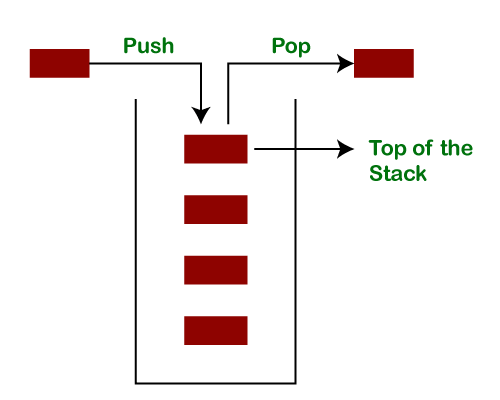 Let's push 20, 13, 89, 90, 11, 45, 18, respectively into the stack. 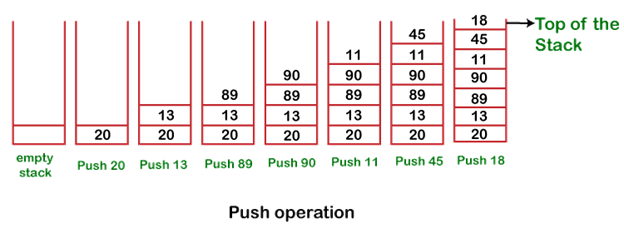 Let's remove (pop) 18, 45, and 11 from the stack. 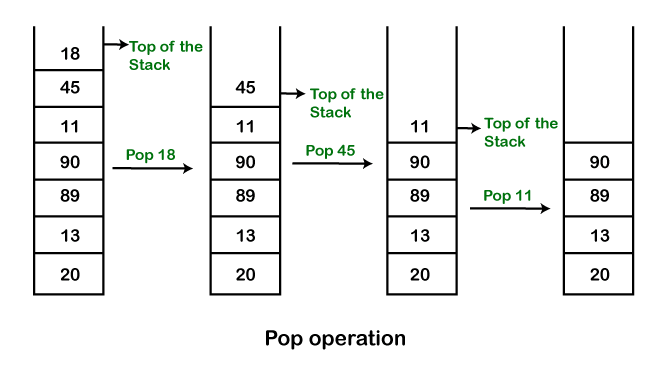 Empty Stack: If the stack has no element is known as an empty stack. When the stack is empty the value of the top variable is -1. 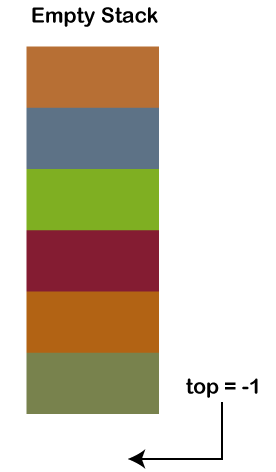 When we push an element into the stack the top is increased by 1. In the following figure,
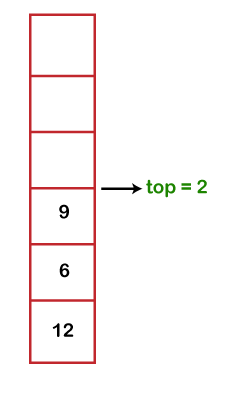 When we pop an element from the stack the value of top is decreased by 1. In the following figure, we have popped 9. 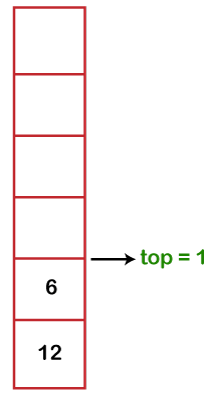 The following table shows the different values of the top. 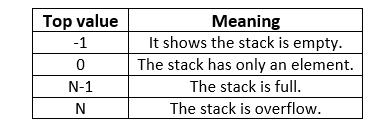 Java Stack ClassIn Java, Stack is a class that falls under the Collection framework that extends the Vector class. It also implements interfaces List, Collection, Iterable, Cloneable, Serializable. It represents the LIFO stack of objects. Before using the Stack class, we must import the java.util package. The stack class arranged in the Collections framework hierarchy, as shown below. 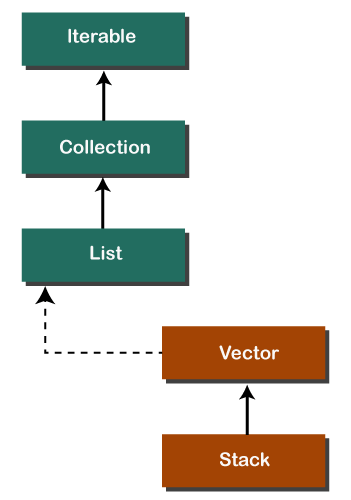 Stack Class ConstructorThe Stack class contains only the default constructor that creates an empty stack. Creating a StackIf we want to create a stack, first, import the java.util package and create an object of the Stack class. Or Where type denotes the type of stack like Integer, String, etc. Methods of the Stack ClassWe can perform push, pop, peek and search operation on the stack. The Java Stack class provides mainly five methods to perform these operations. Along with this, it also provides all the methods of the Java Vector class.
Stack Class empty() MethodThe empty() method of the Stack class check the stack is empty or not. If the stack is empty, it returns true, else returns false. We can also use the isEmpty() method of the Vector class. Syntax Returns: The method returns true if the stack is empty, else returns false. In the following example, we have created an instance of the Stack class. After that, we have invoked the empty() method two times. The first time it returns true because we have not pushed any element into the stack. After that, we have pushed elements into the stack. Again we have invoked the empty() method that returns false because the stack is not empty. StackEmptyMethodExample.java Output: Is the stack empty? true Elements in Stack: [78, 113, 90, 120] Is the stack empty? false Stack Class push() MethodThe method inserts an item onto the top of the stack. It works the same as the method addElement(item) method of the Vector class. It passes a parameter item to be pushed into the stack. Syntax Parameter: An item to be pushed onto the top of the stack. Returns: The method returns the argument that we have passed as a parameter. Stack Class pop() MethodThe method removes an object at the top of the stack and returns the same object. It throws EmptyStackException if the stack is empty. Syntax Returns: It returns an object that is at the top of the stack. Let's implement the stack in a Java program and perform push and pop operations. StackPushPopExample.java Output: stack: [] push -> 20 stack: [20] push -> 13 stack: [20, 13] push -> 89 stack: [20, 13, 89] push -> 90 stack: [20, 13, 89, 90] push -> 11 stack: [20, 13, 89, 90, 11] push -> 45 stack: [20, 13, 89, 90, 11, 45] push -> 18 stack: [20, 13, 89, 90, 11, 45, 18] pop -> 18 stack: [20, 13, 89, 90, 11, 45] pop -> 45 stack: [20, 13, 89, 90, 11] pop -> 11 stack: [20, 13, 89, 90] Stack Class peek() MethodIt looks at the element that is at the top in the stack. It also throws EmptyStackException if the stack is empty. Syntax Returns: It returns the top elements of the stack. Let's see an example of the peek() method. StackPeekMethodExample.java Output: Stack: [Apple, Grapes, Mango, Orange] Element at the top of the stack: Orange Stack Class search() MethodThe method searches the object in the stack from the top. It parses a parameter that we want to search for. It returns the 1-based location of the object in the stack. Thes topmost object of the stack is considered at distance 1. Suppose, o is an object in the stack that we want to search for. The method returns the distance from the top of the stack of the occurrence nearest the top of the stack. It uses equals() method to search an object in the stack. Syntax Parameter: o is the desired object to be searched. Returns: It returns the object location from the top of the stack. If it returns -1, it means that the object is not on the stack. Let's see an example of the search() method. StackSearchMethodExample.java Java Stack OperationsSize of the StackWe can also find the size of the stack using the size() method of the Vector class. It returns the total number of elements (size of the stack) in the stack. Syntax Let's see an example of the size() method of the Vector class. StackSizeExample.java Output: Is the stack empty or not? false The stack size is: 5 Iterate ElementsIterate means to fetch the elements of the stack. We can fetch elements of the stack using three different methods are as follows:
Using the iterator() MethodIt is the method of the Iterator interface. It returns an iterator over the elements in the stack. Before using the iterator() method import the java.util.Iterator package. Syntax Let's perform an iteration over the stack. StackIterationExample1.java Output: BMW Audi Ferrari Bugatti Jaguar Using the forEach() MethodJava provides a forEach() method to iterate over the elements. The method is defined in the Iterable and Stream interface. Syntax Let's iterate over the stack using the forEach() method. StackIterationExample2.java Output: Iteration over the stack using forEach() Method: 119 203 988 Using listIterator() MethodThis method returns a list iterator over the elements in the mentioned list (in sequence), starting at the specified position in the list. It iterates the stack from top to bottom. Syntax Parameter: The method parses a parameter named index. Returns: This method returns a list iterator over the elements, in sequence. Exception: It throws IndexOutOfBoundsException if the index is out of range. Let's iterate over the stack using the listIterator() method. StackIterationExample3.java Output: Iteration over the Stack from top to bottom: 988 203 119 Next TopicJava Tutorial
|